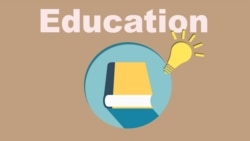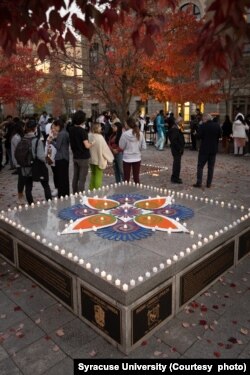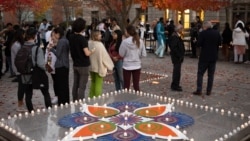The number of international students coming to the United States has dropped in recent years.
Experts noted three reasons for the decrease: concerns about U.S. policies toward foreigners, efforts from Canada, Australia and Britain to gain international students, and the COVID-19 pandemic.
But the latest Open Doors report showed that international students are coming back to the U.S.
The yearly study looks at the number of international students in the U.S. It also looks at how many American students are going away for school.
China remains the country that sends the most students to the U.S. But India is closing the gap according to the 2022 report. The number of students from India increased by 19 percent while those from China dropped by nine percent in the most recent school year.
VOA Learning English recently spoke with three Indian students to learn more about their reasons for coming to the U.S.
Shivani Sadare
Shivani Sadare is from Pune, a community near the western Indian city of Mumbai. Sadare is in her first year studying for an advanced degree at Syracuse University in New York. She came to the U.S. after completing college in India and getting some work experience.
Sadare said she and many Indian students have delayed their studies in the U.S. because of the COVID-19 pandemic. And one of the reasons for the recent rise is that they are making up for lost time.
Studying in the U.S., Sadare said, gives her more choices. And Indian companies value an advanced degree from the U.S. more than the same degree from a school in India.
“It has the technology, the developing companies and a huge scope,” she said. “If you are doing a master’s, it is easier to grow in the U.S.”
Kartik Sundaram
Kartik Sundaram is studying user experience, an important part of website design, at the University of Michigan. He attended Michigan as an undergraduate and will complete a master’s degree next year.
Sundaram spent most of his time in New Dehli before coming to Michigan five years ago. During his time in Michigan, Sundaram thinks there has been a change in the thinking of students from India.
In the past, he said, Indian students came to the U.S. looking for a better life. Their parents fell in love with the idea that “the U.S. is the best.” But lately, students come to the U.S. looking for a culture change or looking for the school that is the best for them.
“On the whole, everyone was just about the grades and about being the best and about getting into the best university, I think now there is just a little more acceptance that maybe, maybe, just getting into the best university and getting into the best job is not necessarily what it seems to be.”
Mallika Gore
Mallika Gore is a third-year student at Syracuse University. She said Indian students are coming to the U.S. even though it is difficult for them to stay and work after they finish their education.
The student experience, she said, is different in the U.S. “The U.S. explores and promotes a more well-rounded education, which is enticing for us.”
Financial support
All three students said they have been able to study in the U.S. with the help of scholarships and other tuition reductions. Students can pay less for school if they work as teaching assistants or resident advisors.
Gore receives financial support from the Next Genius Scholarship Program. As a graduate assistant, Sundaram gets a small amount of money in addition to free tuition. Sadare also has a scholarship.
Since the cost of education is very high in the U.S., Sundaram said some Indian students choose less costly education in Hong Kong, Singapore and Germany. And the strong U.S. dollar against the Indian rupee does not help.
Five years ago, Sundaram said, it was about 63 rupees to buy one dollar. Today, one dollar costs about 80 rupees.
Allen Koh is the chief executive of Cardinal Education, a U.S.-based company that helps students prepare their college applications. Koh’s company works with many international students each year.
Even before the start of the COVID-19 pandemic, he saw signs that more Indian students would be coming to the U.S. But the Open Doors report only showed it this year.
“[Indians] are very attracted to the American story,” Koh said. “There are so many Indian-Americans who have skyrocketed to the top echelons of business and technology here.”
Koh advised students to look for universities that are one level below the very top. Those schools, Koh said, will likely have scholarship money for strong international students.
Koh said he expects to get more business from India shortly. He is planning to visit to speak with students and families soon.
“And we're not traveling for work yet. But India is going to be my first stop when we do start, and we will probably be going into at least four cities.”
I’m Dan Friedell. And I’m Faith Pirlo.
Dan Friedell wrote this story for Learning English.
_______________________________________________________________
Words in This Story
gap –n. a missing space between two things
advanced –adj. beyond the most basic level
scope –n. space or opportunity for something (such as study or thought)
undergraduate –n. the level of college after high school
promote –v. to say good things about something, to help something develop
enticing –adj. appealing or attractive; interesting
scholarship –n. money set aside for students by organizations such as universities or charities
tuition –n. the cost of going to school
echelon –n. a level in an organization or structure
______________________________________________________________
We want to hear from you. Are you a student from India thinking of coming to school in the U.S.? What is your plan?
We have a new comment system. Here is how it works:
- Write your comment in the box.
- Under the box, you can see four images for social media accounts. They are for Disqus, Facebook, Twitter and Google.
- Click on one image and a box appears. Enter the login for your social media account. Or you may create one on the Disqus system. It is the blue circle with “D” on it. It is free.
Each time you return to comment on the Learning English site, you can use your account and see your comments and replies to them. Our comment policy is here.















Forum